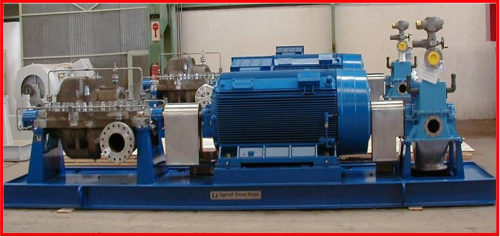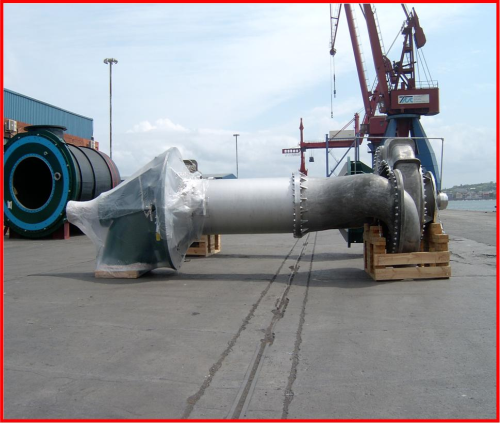

The surface of the earth is covered by approximately 30% land and 70% water. Of the water, the vast majority (97%) is salt water, found in oceans. Only 3% of the earth’s water is fresh water, and of this 3% only one third is usable, with the remaining two thirds being locked up in ice and glaciers. With the dramatic rise in world population, and the ever increasing requirements of industry, the need for fresh water is being met by sea water desalination.
The concept of desalination is very old, with references to it being found in ancient Egyptian, Sanskrit, Hebrew, Phoenician and Greek writings. In 1790, the US Secretary of State, Thomas Jefferson, received an offer to sell the government a scheme to convert salt water to fresh water, with the objective of avoiding any deaths at sea. The results of the tender described a simple distillation process. The first desalination units were eventually built for ships. However, they were not for drinking water, but rather to provide fresh boiler water, so that steam ships would not be forced to travel with cargo holds full of water. By World War II, there were hundreds of mobile desalination units in use, and all major vessels were equipped with them.
Main types of desalination
The first desalination plants for domestic water supply were constructed in the Middle East in the development period after World War II. Nowadays there are more than 15,000 desalination plants in operation around the world, and these are split into five main types:
Reverse osmosis
Multi-stage flash
Electro-dialysis
Multi-effect distillation
Vapour compression
Of these five processes, reverse osmosis and multi-stage flash are by far the most prevalent, with 86% of the world’s capacity being provided by them.
Reverse osmosis
Certain semi-permeable membranes exist in nature, such as animal and cell walls, which allow water to pass through them, creating an equilibrium between a highly concentrated solution on one side and a more diluted solution on the other. Faced with the conundrum of creating fresh water from salt water, without the huge amounts of energy required by distillation, scientists hypothesized that with the right amount of pressure and the correct man-made membrane, the natural phenomenon of osmosis could be reversed. In order for this to occur, a pressure higher than the osmotic pressure must be applied to the solution of higher concentration. This forces the water through the membrane, whilst leaving the salt behind. In some respects, the process can be likened to a form of very fine filtration. The pressure required depends on the concentration of salt in the water. However, for the majority of sea water applications, the pressure is around 70 bar (1000 psi).
In the 1960s such membranes were developed in the USA and in Japan, and plant developers began to construct reverse osmosis facilities. In Europe the first reverse osmosis plant was commissioned in 1964 on the island of Lanzarote. Since this time, Spain has become the fourth largest user of desalination, behind Saudi Arabia, the United Arab Emirates and Kuwait.
There are many different types of pump used throughout reverse osmosis plants. In order to achieve the flow and pressure required, the main feed pumps are usually of the multistage centrifugal type, with an axially split casing to facilitate ease of maintenance. A typical pump train is shown (above).
Multi Stage Flash (MSF)
Unlike reverse osmosis, the multi-stage flash process relies on distillation of the sea water, with it being heated and condensed over a multitude of stages. The MSF process was invented and patented by Weirs of Cathcart, Scotland in 1957 and saw significant development and wide application throughout the ‘sixties.
Heated brine is introduced to a chamber (stage) where the pressure is below the saturated vapour pressure of the brine at that temperature. Immediate conversion to the vapour phase (flashing) takes place and the resulting vapour passes to the next stage.
After passing through a demister, a proportion of this vapour is then condensed on the tubes of the second stage, giving up its latent heat of vaporisation to the feed stream. The feed stream is heated progressively in each stage before passing through the brine heater used to feed the first stage.
The condensate collected in each stage forms the product, and the whole process is driven by the sub-atmospheric pressure gradient through the stages, generated at start-up by a steam ejector, but maintained by progressive condensation. The MSF process benefits from both the economy of scale and its ability to operate on low grade steam, resulting in its widespread use worldwide.
The pumps at the heart of the MSF process are the brine recirculation pumps. Although the pressure required to re-circulate the brine through the flash chambers is much lower than that of the feed pumps in the RO process, the pumps have a much higher flow-rate, and are supplied in a vertical configuration. The materials are also more exotic, since the brine is recycled at a temperature of around 80 degrees Celsius. This makes the service extremely corrosive.
The brine recirculation pump shown is for installation in a major MSF plant in the Middle East. The pump is more than 7m long, with a diameter greater than 4m.
Summary
In the last few years, major desalination plants have been constructed in countries which previously were able to rely on natural fresh water sources, such as Australia, India, China and Algeria. Even the UK is now constructing its first large scale desalination plant at Beckton (Newham). As world population rises, and as developing countries improve their standard of living, there will be an ever increasing demand for fresh water, and this will be met by desalination.
Article from WaterWords, newsletter of the Waterworks Museum - Hereford, UK, spring 2009 edition





